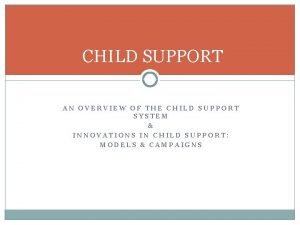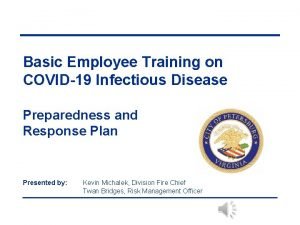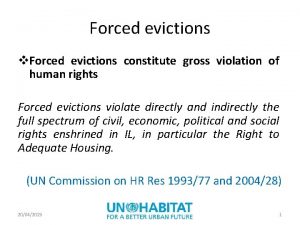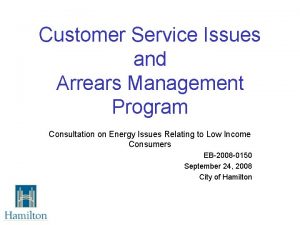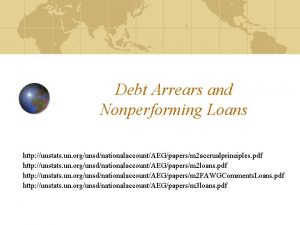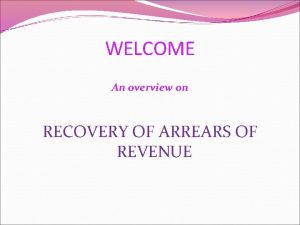The Impact of Covid19 on Arrears Evictions and








- Slides: 8

The Impact of Covid-19 on Arrears, Evictions and Homelessness in the Private Rented Sector in England Christine Whitehead LSE c. m. e. whitehead@lse. ac. uk

Government policy on private renting General: Most tenants have Assured Shorthold tenancies (ASTs) which generally run for six months of a year. They can be renewed. Tenants may be given notice to leave at the end of the tenancy under S 21 (no fault) evictions or (both private and social) through S 8 rent arrears. Formal notices and legal process required (not for lodgers) Specific to covid: • Moratorium on evictions to 29 th August and then to 20 th September. • From 29 th August the landlord must in most cases give 6 months notice before issuing a formal eviction notice until end March 2012 • Shorter periods if significantly in rent arrears. • Welfare changes - £ 20 per week extra Universal Credit until April 2021. • Local housing allowance rates raised back to 50% of local market.

Evidence on rent arrears • There are roughly 4. 5 m private tenants in the UK. • Latest estimates suggest that around 6% of tenants were in arrears in August/September 2020 and perhaps a further 7% had made some arrangement with their landlord. • Arrears are highly correlated with unemployment – which is expected to more than double from the 4. 1% measured in July – more if there are more lockdowns. • This would imply between 550, 000 - 700, 000 tenants in arrears. Maybe higher because younger.

Arrears into Evictions • Only a small proportion of those who have arrears will receive even a formal eviction notice let alone actually be evicted, • Around 10 - 15% of those in arrears over any given year are issued with a formal notice. The courts then issue and order in around 75% of these cases – and about half of those orders actually lead to formal repossessions. Working through these stages suggests maybe 42, 000 – 52, 000 formal evictions. • These figures could be higher if landlords take more action than usual. But in reality they are likely to be lower for two reasons (i) the six months notice period gives a lot more time to adjust in one way or another; and (ii) the courts are simply not going to be able to cope.

The options for others? • To remain and negotiate an arrangement with the landlord (which is great – especially if the tenant gets another job – but cannot go on for ever) or borrow e. g. from their family; • To find alternative, cheaper or more crowded, rental accommodation; • To go back to Mum and Dad (especially because many of those who will lose jobs are relatively young). In the early stages of the pandemic the evidence showed that the majority of those under 35 moved back home ; while in the USA the latest figures suggest over 50% of those under thirty are now living with parents; or • To approach the local authority for support in finding accommodation. • A major longer term concern is what happens to their credit rating if they simply walk away. i

What proportion will end up homeless? • Our estimate is very similar to that made by the Resolution Foundation earlier in the year – although arrived at differently. • In 2019 some 15, 000 households were accepted as in need of temporary accommodation. • In the coming year based on the relationship between eviction orders and homelessness acceptances there will probably be at least 3 times that number offered temporary accommodation – ie around 45, 000. • Two elements will limit these numbers- the very long notice period and the fact that most younger single people who come forward for assistance will only be eligible for advice rather than accommodation. • Even so the cost to government will be around £ 225 m if we assume they reamin in temporary accommodation for an average of 6 months.

What about the landlords? • The only way they have been helped is through the mortgage holiday – which has just been extended to a total of six months. • Up till now nearly a quarter of landlords have lost some money but only 3% have lost more than half their income. • Otherwise they have been encouraged to make agreements with their tenants - but this is getting harder for them as the periods involved increases. • A major concern is that 9% of landlords have had tenants who walk away without notice because both of loss of income but also delays in being able to re-let. • A core longer term issue is the scarring for both tenants and landlords and how this will change decisions.

Initial reference https: //trustforlondon. fra 1. digitaloceanspaces. com/media/doc uments/Where_now_for_the_private_rented_sector. pdf
